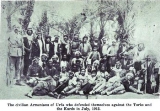
Urfa Resistance
Encyclopedia
Urfa Resistance or Urfa Rebellion was the Armenian resistance in Urfa during World War I
developed as a reaction to actions of the Ottoman government
(see Armenian Genocide
). The resistance was quelled following German
intervention.
On May 27, 1915, several hundred Armenians were held captive by Ottoman authorities in Urfa. The community held a meeting in order to adopt a solution. The participants thought of many different tactics. Mgrdich Yotneghparian and his partisans were among the few who preferred to fight to the death rather than yielding to the Ottomans. The Adana massacre
of 1909 had made Yotneghparian increasingly cautious of the new Young Turk government and the Turkish constitution.
Led by the charismatic Mgerdich, the resistance of the Armenian fighters in the heavily fortified stone houses lasted sixteen days and was eventually broken only with the help of a reinforcement contingent of six thousand Turkish troops, reportedly equipped with heavy artillery.
World War I
World War I , which was predominantly called the World War or the Great War from its occurrence until 1939, and the First World War or World War I thereafter, was a major war centred in Europe that began on 28 July 1914 and lasted until 11 November 1918...
developed as a reaction to actions of the Ottoman government
Ottoman Empire
The Ottoman EmpireIt was usually referred to as the "Ottoman Empire", the "Turkish Empire", the "Ottoman Caliphate" or more commonly "Turkey" by its contemporaries...
(see Armenian Genocide
Armenian Genocide
The Armenian Genocide—also known as the Armenian Holocaust, the Armenian Massacres and, by Armenians, as the Great Crime—refers to the deliberate and systematic destruction of the Armenian population of the Ottoman Empire during and just after World War I...
). The resistance was quelled following German
Germany
Germany , officially the Federal Republic of Germany , is a federal parliamentary republic in Europe. The country consists of 16 states while the capital and largest city is Berlin. Germany covers an area of 357,021 km2 and has a largely temperate seasonal climate...
intervention.
On May 27, 1915, several hundred Armenians were held captive by Ottoman authorities in Urfa. The community held a meeting in order to adopt a solution. The participants thought of many different tactics. Mgrdich Yotneghparian and his partisans were among the few who preferred to fight to the death rather than yielding to the Ottomans. The Adana massacre
Adana massacre
The Adana massacre occurred in Adana Province, in the Ottoman Empire, in April 1909. An massacre of Armenian Christians in the city of Adana amidst governmental upheaval resulted in a series of anti-Armenian pogroms throughout the district...
of 1909 had made Yotneghparian increasingly cautious of the new Young Turk government and the Turkish constitution.
Led by the charismatic Mgerdich, the resistance of the Armenian fighters in the heavily fortified stone houses lasted sixteen days and was eventually broken only with the help of a reinforcement contingent of six thousand Turkish troops, reportedly equipped with heavy artillery.

